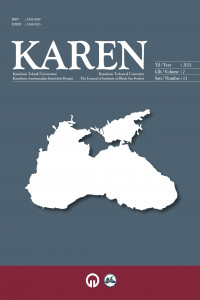TRABZON/ARAKLI’DA GEÇ DÖNEM OSMANLI CAMİİ MİHRAPLARINDA TİPOLOJİ VE BEZEME
TYPOLOGY AND DESIGN OF LATE OTTOMAN MOSQUE MIHRABS IN TRABZON/ARAKLI
Author(s): Raziye Çiğdem ÖnalSubject(s): Architecture, Visual Arts, Recent History (1900 till today), Islam studies, 19th Century, The Ottoman Empire
Published by: Karadeniz Teknik Üniversitesi - Karadeniz Araştırmaları Enstitüsü
Keywords: Araklı; Mihrab; Westernization; Empire; Eclectic; Provincial Architecture and Art;
Summary/Abstract: Trabzon, which is open to both land and sea transportation and trade due to being one of the Silk Road's ancient stops and having ports, is one of the cities that has retained its significance throughout history. The town of Araklı dating back to the history of the historical city and being 33 kilometers from the city center is significant because it has a harbor and the city's highways opening to the east since ancient times. With the conquest of the Ottoman Empire in 1461, the district, which had retained its significance since the Roman period, took on Islamic identity, and its population mobility and architectural structures changed its identity in this direction. Although they are few in number, monuments of late Ottoman art can be found in Araklı. The present article focuses on the four mihrabs that reflect those traces and are located in Central Küçük (Hacı Hasan) Mosque (1859-60), Konakönü Quarter Mosque (1884), Central Grand Mosque (1907-08) and Kalecik Quarter Mosque (1910). It was aimed that the findings of the present study, in which the mihrabs are explained in chronological-catalog order and the text is accompanied by drawings and photographs, would contribute to the current literature. While the examined mihrabs share some typological similarities, they differ in terms of the return of Western styles and the decoration program incorporating local elements unique to the Eastern Black Sea Region in a mixed order. These mihrabs, which have reached the present day and inspired intellectual readings about the provincial practices of late Ottoman art, are among the rare works that have taken their place in Turkish cultural memory as precious works of art shaped on the basis of material and spiritual necessity.
Journal: Karadeniz Araştırmaları Enstitüsü Dergisi
- Issue Year: 7/2021
- Issue No: 13
- Page Range: 180-198
- Page Count: 19
- Language: Turkish

